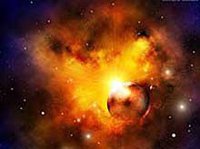What's hidden inside black holes?
 It is traditionally believed that our universe was formed approximately 13 billion years ago after the infamous Big Bang. But why did it happen and what was before it? Employees of Astro Space Center of the Physics Institute (ASC FIAN), Vladimir Lukash and Vladimir Strokov believe that the answer to this question can be a black hole.
It is traditionally believed that our universe was formed approximately 13 billion years ago after the infamous Big Bang. But why did it happen and what was before it? Employees of Astro Space Center of the Physics Institute (ASC FIAN), Vladimir Lukash and Vladimir Strokov believe that the answer to this question can be a black hole.
It is nearly impossible to get any reliable information about the black hole, because the force of its gravity is so high that even light particles - photons - cannot break from it. According to scientists, there is a zone inside the hole called singularity, where there is neither space nor time, and the density tends to infinity.
It is assumed that the universe emerged from the singularity. That is, before there was a certain point that does not have any physical parameters familiar to us. But then there was an explosion, and the universe began its countdown. Meanwhile, if initially there was nothing there, then where did the bang come from?
Head of the Department of Theoretical Astrophysics ASC FIAN, Doctor of Physical and Mathematical Sciences Vladimir Lukash and his colleague Vladimir Strokov decided to simulate the situation that allows one to look at the singularity area and see what happens there.
"Of course, as before, it is impossible to immediately get into this astronomical object," says Lukash. "But we were able to track the process of passing of the photons through these zones, where the laws of the classical theory of relativity are not applicable, on the mathematical model."
What happened? It turned out that the substance which gets inside the black hole from our area is converted into an enormous amount of gravitational energy, generating a new universe on the other side of the hole.
"The effect of particle creation in varying fields, including gravity, is known to physics," said Vladimir Lukash.
"When a star collapses into a black hole, a strong gravitational field is generated that causes production of particles. And then, since the impetus for the expansion has already been given, processes come into play that pick up material and inflate it to a large amount. "
This finding helps to clarify the origin of our universe. It turns out that it represents a certain configuration of gravitating matter that billions of years ago just "blew out" like a, bubble, from the black hole.
"So we are on the other side of the black hole that exists in some other, unknown to us Universe," gives a simplified explanation co-author on the study, Vladimir Strokov.
The Big Bang theory has not been eliminated yet, but its reasons were different than previously thought: it did not come as a result of "undermining" of a facility that has very high energy density, temperature and pressure, but was the result of the impact of powerful gravitational fields, particulate emissions from the black hole matter to "our" side. Further, says Vladimir Strokov, newly formed universe began to expand according to the cosmological principles.
So the theory that black holes can be a point of transition in parallel universes or other temporary measure is not that fantastic. Of course, we cannot reach any of the black holes and test it. However, these assumptions are well within the framework of scientific theories.
Recently, another member of the Moscow Institute of Nuclear Research Vyacheslav Dokuchaev suggested a truly sensational hypothesis that supermassive black holes can contain not only micro-particles - photons and protons - but entire planets that can rotate within a hole around the central singularity on stable orbits. At the same time such planets can in principle have complex reactions between chemicals and, therefore, it is possible that there could exist life like ours.
Thus, we can expect to meet our brothers both in the black hole and on the other side of it. We cannot find out whether they live there because we cannot get inside the hole, and computer models built by astrophysics are at the time not advanced enough to tell us more details about this "other-worldly" life.
Irina Shlionskaya
Pravda.Ru
Subscribe to Pravda.Ru Telegram channel, Facebook, RSS!




